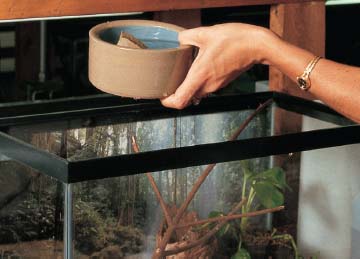
HOUSING AND MAINTENANCE
Selecting an Enclosure
All-glass aquaria with screen tops are suitable enclosures for water dragons. The enclosure should be at least twice the length of the animal(s) being kept, preferably larger. Following these size guidelines, an adult pair of water dragons (each measuring approximately 3 feet long) requires at least a 6-foot, 100-gallon aquarium: the greater the width, the better. Although a 10-gallon aquarium is suitable for a hatchling, you should initially purchase at least a 30-inch-long (29-gallon) enclosure, which will be suitable for about eighteen months. After that time, consider purchasing the final vivarium for your animal(s). You can also use custom-built wood enclosures with a glass front. The wood should be coated with several coats of polyurethane or epoxy paint. Custom-built enclosures allow you to provide a greater width and height than normally available in all-glass aquaria. They also allow more room for plants and branches, and their front opening doors facilitate cleaning, maintenance, and access to the animals.

Provide a water container deep enough to allow your dragons to submerge themselves up to half their body height. The container shown here would work for juvenile lizards, but a wider pan is needed for adults.
Water dragons are tropical, semi-arboreal lizards that live near water. Their enclosures should have diagonally placed branches as resting areas, a substrate (ground medium) that can retain some moisture, a large water container or water section, adequate light, and adequate heat. For display purposes, you can add suitable plants to the enclosure.
Substrate
In vivaria, maintain water dragons on small-grade orchid bark or on a mixture consisting of two-thirds peat moss based potting soil and one-third sand. Some keepers use artificial grass carpets as substrate for their pets.
Landscaping
To provide suitable climbing and resting areas, diagonally place several branches in the vivarium, each with a diameter nearly equal to the girth of your animal’s body. Rounded natural cork bark sections make excellent branches for vivaria. Cork is attractive and can be easily disinfected when necessary—simply dip the cork in a 5-percent bleach solution for at least 15 minutes, then rinse it with water.
Plants
Many species of live dragon plants (Dracaena) do well in water dragon enclosures, including the “cornstalk plant” (Dracaena fragrans massangeana). If planted at an angle within the pots or in the ground medium, the trunks provide natural looking, attractive resting areas.
For decorative purposes, use other plants, such as cut-leaf philodendrons (Monstera deliciosa) or pothos (Scindapsus aureus), as backgrounds. Epiphytes, such as staghorn ferns (Platycerium sp.), can be grown on sphagnum moss attached to the walls of the vivarium.
Over time, your water dragon may damage plants, which may need to be removed and replaced. After removing damaged plants, replant them and give them time to generate new leaves. When the next set of plants becomes damaged, simply replace them with the originals.
Number of Water Dragons Per Enclosure
You can keep green water dragons and Australian water dragons in groups of one male and up to four females. In room-sized enclosures, two or three males and several females can be kept together. The males of these two species are not very aggressive with each other. Typical interactions involve head bobbing and chasing, behaviors that are more prominent during the breeding season. It is a good idea to carefully monitor any males kept together. Subdominant males may spend a large amount of time hiding and, therefore, may not feed adequately. Stress may also cause the subdominant animal to decline.
Water
Keep water available to your water dragons at all times. Supply a container large enough for water dragons to enter and immerse themselves up to half of their body height. Large, plastic cat litter pans make good water containers for adults. Place the container in the ground medium in such a way that green water dragons can readily enter or exit. For cleaning, disinfecting, and water replacement purposes, make sure that the container is easy to remove. Ideally, the water in the container should be changed daily, although every two days is adequate as long as the animals haven’t defecated in the water. Water dragons tend to splash around and defecate within minutes of receiving a fresh pan of water, so remove and clean the pan within a half hour and refill it with clean water. Fortunately, water dragons defecate in their water container so regularly that you will seldom need to replace the substrate.
Standard water dragon maintenance includes a quick daily visual health check of your animal, regular water replacement and feeding, and plant and glass upkeep. Replace the substrate as needed. This will depend on the size of the vivarium; large enclosures require two to three substrate changes each year, and exceptionally large enclosures need only one change per year.